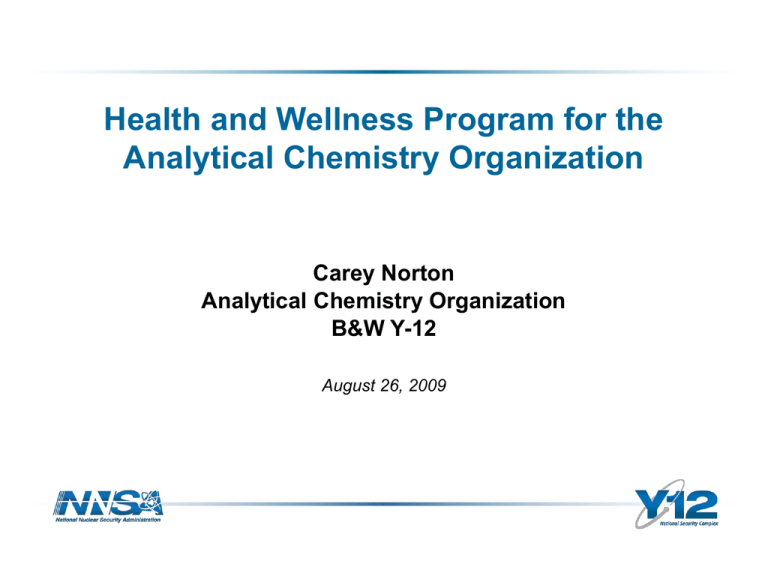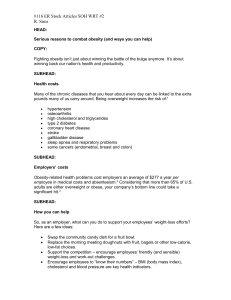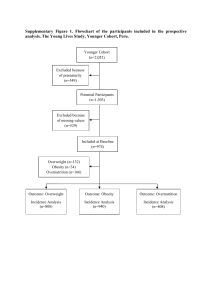Health and Wellness Program for the Analytical Chemistry
advertisement

Health and Wellness Program for the Analytical Chemistry Organization Carey Norton Analytical Chemistry Organization B&W Y-12 August 26, 2009 DISCLAIMER This work of authorship and those incorporated herein were prepared by Contractor as accounts of work sponsored by an agency of the United States Government. Neither the United States Government nor any agency thereof, nor Contractor, nor any of their employees, makes any warranty, express or implied, or assumes any legal liability or responsibility for the accuracy, completeness, use made, or usefulness of any information, apparatus, product, or process disclosed, or represents that its use would not infringe privately owned rights. Reference herein to any specific commercial product, process, or service by trade name, trademark, manufacturer, or otherwise, does not necessarily constitute or imply its endorsement, recommendation, or favoring by the United States Government or any agency or Contractor thereof. The views and opinions of authors expressed herein do not necessarily state or reflect those of the United States Government or any agency or Contractor thereof. COPYRIGHT NOTICE This document has been authored by a subcontractor of the U.S. Government under contract DE-AC0500OR-22800. Accordingly, the U.S. Government retains a paid-up, nonexclusive, irrevocable, worldwide license to publish or reproduce the published form of this contribution, prepare derivative works, distribute copies to the public, and perform publicly and display publicly, or allow others to do so, for U. S. Government purposes. Carey Norton - Bio • Chemical Hygiene Officer and Safety Coordinator for the Analytical Chemistry Organization at B&W Y-12 • M.S. in Safety (industrial/occupational) • B.S. Biology, minor in chemistry Introduction • Overweight and obesity are both labels for ranges of weight that are greater than what is generally considered healthy for a given height. • The terms also identify ranges of weight that have been shown to increase the likelihood of certain diseases and other health problems • Treatment for overweight and obesity requires lifestyle changes which may include: – Reducing calorie intake – Following a healthy eating plan – Being physically active – Making behavioral changes Definitions • Overweight and obesity ranges are determined by using a person’s weight and height to calculate their "body mass index" (BMI) • BMI generally provides a reliable indicator of body fatness for most people and is used to screen for weight categories that may lead to health problems – An adult who has a BMI between 25 and 29.9 is considered overweight. – An adult who has a BMI of 30 or higher is considered obese Health Consequences • Coronary heart disease • Type 2 diabetes • Cancers (endometrial, breast, and colon) • Hypertension (high blood pressure) • Dyslipidemia (for example, high total cholesterol or high levels of triglycerides) • Stroke • Liver and Gallbladder disease • Sleep apnea and respiratory problems • Osteoarthritis (a degeneration of cartilage and its underlying bone within a joint) • Gynecological problems (abnormal menses, infertility) Where do we Stand? • The Centers for Disease Control (CDC) indicate that Tennessee has the third highest rate of obesity (BMI > 30) in the nation with 30.1% of its residents considered to be obese Statistics • According to Y-12 Occupational Health Services (OHS), 40% of employees evaluated by OHS were overweight or obese in 2008 • Diabetes is the leading cause for insurance claims filed by Y12 employees • Back pain and coronary artery disease (CAD) are the second and third highest cause for insurance claims at Y-12 Barriers to Healthy Living • Lack of Knowledge--Individuals are aware of dangers involved with excessive weight or obesity, but lack knowledge to overcome unhealthy habits • Lack of resources--Individuals may be unfamiliar with vast resources that are available to combat obesity • Lack of reinforcement--Many individuals may have great intentions to start a diet or exercise plan, but the system may fail quickly because the person does not receive the positive support from significant others • Lack of motivation--Many folks neglect their health because the pleasures from routine habits simply “out-weigh” the effort to achieve and/or maintain a healthy living lifestyle Keys to Success • Benefits of weight loss can include: – Improved health – Disease prevention – Increased energy – Increased confidence – Lower insurance costs • Wellness programs can help employees in their journey to a healthier way of life • Group programs may be more beneficial in providing support and motivation for the participants • Support from management can encourage more participation in such programs Program Description • Inspiration taken from the popular television series, “The Biggest Loser” • Twelve week challenge for participants to adopt a more focused approach to health, wellness, and physical fitness • Initiated to overcome the before-mentioned “Barriers to Healthy Living” • Designed to educate, assist, inspire, and motivate individuals to adopt a healthy living lifestyle • Catered to meet a vast variety of fitness goals and objectives • Involved a system of accountability and weekly monitoring of progress Program Description Cont. • Individual goals as well as group goals were determined • 41 participants were divided into 5 teams • A variety of contests help ensure participation, excitement, and motivation • Consistent weekly weigh-ins were conducted for accountability and progression • Weekly individual and group progress reports were distributed • Formalized recognition program for weekly and final achievement Contests • "Biggest loser" individual --- determined by % body weight lost (Male category and female category) • Group competition5 teams competing for the title "Biggest Loser group“ determined by group % body weight lost • Personal goal setting achievement--Each participant was asked for a perceived goal, and would be evaluated at the end of 12 weeks to monitor achievement or level of success Instruction/ Reinforcement • Each week weigh-ins were conducted and the results were posted for the Top 10 cumulative weight loss “Individual Losers”. Group results were also monitored and shared weekly. • The Union Valley group held weekly meetings hosted by health and fitness experts from within the Y-12 facility • Some participants held weekly lunchroom discussions and participated in walks during lunch • Several family members of the Y-12 employees became involved due to the nature of the event and the results that were being achieved Recognition • 1st-3rd Place individual winners from the male/ female category • Group winner • Goal achievement recognition • Special awards of outstanding achievement • Several vendors have volunteered their services and have contributed to the success of this program Results • At the end of the 12 week period, the Biggest Loser participants lost a combined weight of 401.5 pounds !!! • The average weight loss per individual was 5% • Nine participants lost over 10% of their body weight • The winning group (of the 5 participating groups) was 9995 Sample Management which lost an incredible 7.7 % of their weight (129 total pounds)! • The Biggest Loser Male was from the Union Valley group, losing 14.4 % of his weight • The Biggest Loser Female was from the Union Valley group as well, losing 10.2 % of her weight Response • This program has been well received by the group as well as supervisors and management – many have expressed interest in a continued program • Some participants are now preparing for their first 5K foot race, others have formed a hiking group, others have become actively involved in a walking routine (often during their lunch break) • Many say their attitude has changed, spouses are involved, they have more energy and stamina, etc • Many proclaimed proudly, "I haven't weighed this in ____ years!" After hearing from so many, I tallied the responses up and we now have erased 135+ years of cumulative weight gain! In Conclusion… • A small group of the Y-12 population has now become more energetic, developed more stamina, improved blood chemistry while reducing the burdens that are associated with excessive body weight • Participants are more confident and take pride in their fitness level, and enjoy sharing like-minded interest with others in the work place • A continued program would be beneficial to help maintain the positive results achieved by this 12 week challenge References • Centers for Disease Control – Overweight and Obesity Topics http://www.cdc.gov/obesity/index.html • National Institutes of Health – Obesity Topics http://health.nih.gov/topic/Obesity






